and the origins of jacarandas in Sydney
Jacaranda trees (Jacaranda mimosifolia) are widely known for their stunning purple blossoms, and they are a common sight in various parts of Sydney, Australia.
The native habitat of the Jacaranda tree is not in Australia but rather in parts of South America. Native to tropical and subtropical regions of South America, specifically in countries such as Brazil, Argentina, and Uruguay. In its native habitat, the Jacaranda tree is well adapted to warm climates and can be found growing in a variety of environments, including open woodlands, grasslands, and along riverbanks. The tree is known for its striking blue-purple blossoms and fern-like foliage.
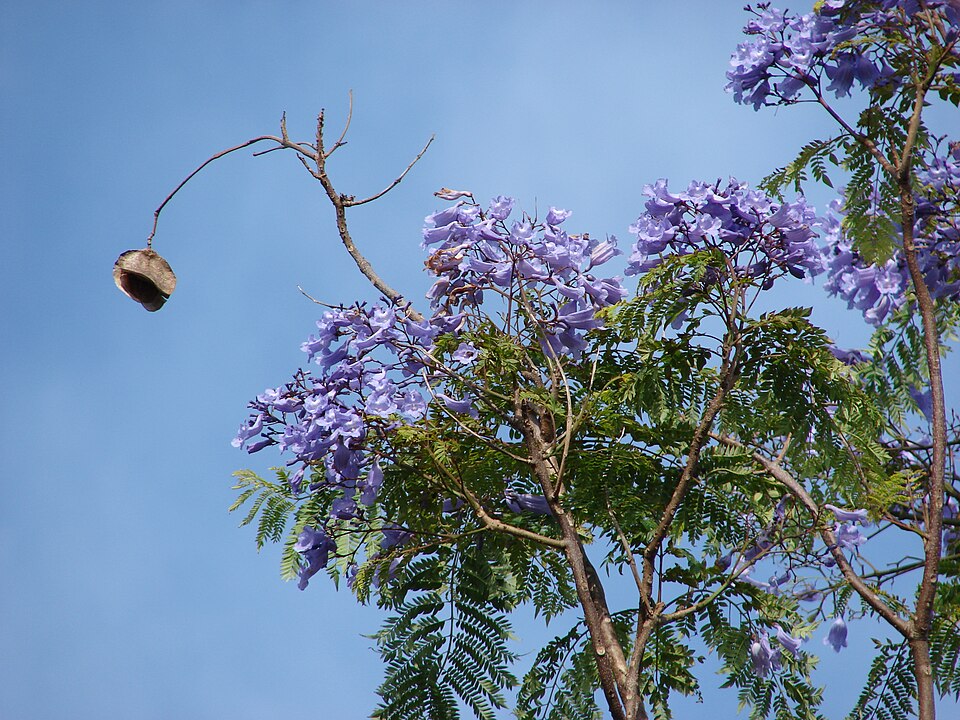
jacaranda season in Sydney
Although the jacaranda is not native to Australia, the abundance of these beautiful trees across Sydney could easily mislead you into thinking they are. Stand on any hill or high point that offers an aerial vista over any Sydney suburb from October to December and you will see vibrant patches of purple scattered amongst the terracotta roof tiles in all directions. It is Sydney’s version of “cheery blossom season.”
Some streets and neighbourhoods have particularly high concentrations of jacarandas and have built up a reputation for putting on a spectacular sight to behold.
The Most famous are:
- McDougall Street, Kirribilli
- Milson Park, Kirribilli
- The University of Sydney, Camperdown
- Oxford Street & Glenmore Road, Paddington
- Five Ways, Paddington
- Pearce Street, Double Bay
- The Royal Botanic Gardens, Sydney City
However, there is one area that has been completely overlooked. Considering its proximity to public transport, cool cafes, pubs, bars, restaurants, and classic architecture it is quite amazing that this jacaranda wonderland is not on every person’s spring Instagram roster.
The Jacarandas of Darlinghurst
The suburb of Darlinghurst is located in Sydney’s East between Hyde Park and Paddington. Like many parts of Sydney, some of the jacarandas here were planted in the 1920s while others were planted in the 1970s and 80s. Here you can find blooming purple flowers backdropped with nineteenth-century architecture.
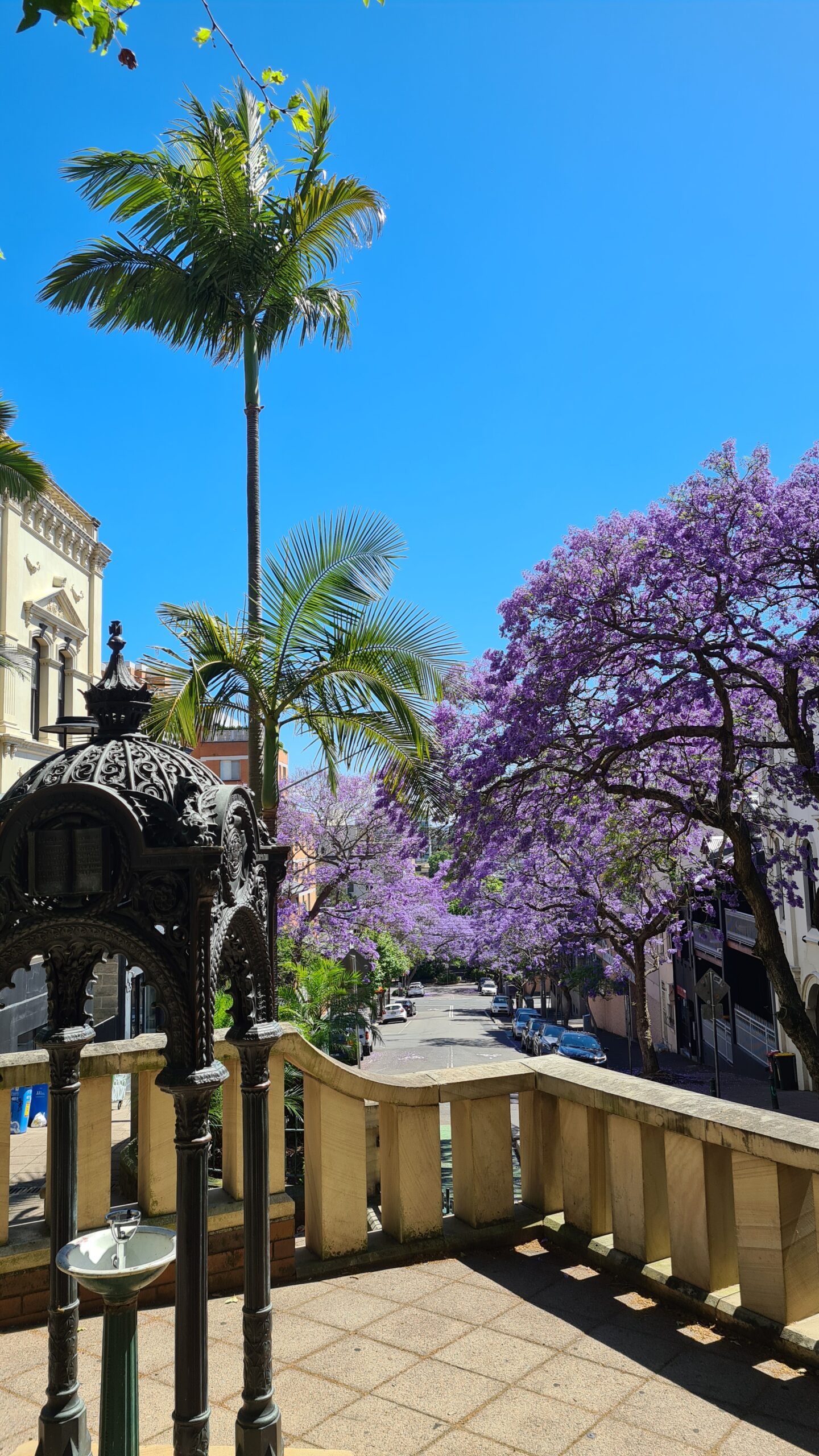
Oxford Square, Darlinghurst
Perhaps the best-kept jacaranda vista in Sydney. Oxford Square sits on the intersection of Oxford Street and Burton Street and looks over Riley Street. It is surrounded by nineteenth-century architecture and has the most charming Victorian-era cast-iron drinking fountain. The jacaranda trees were planted in the 1970s and are therefore not as old as others in the area. Nonetheless, they contrast well with the palms and the whole scene makes the perfect backdrop for a portrait or cheeky selfie. After you take your photos, you can have coffee and brunch at Theeca Cafe (1 Burton Street), overlooking the lavender view. The cafe’s alfresco dining is on Oxford Square.
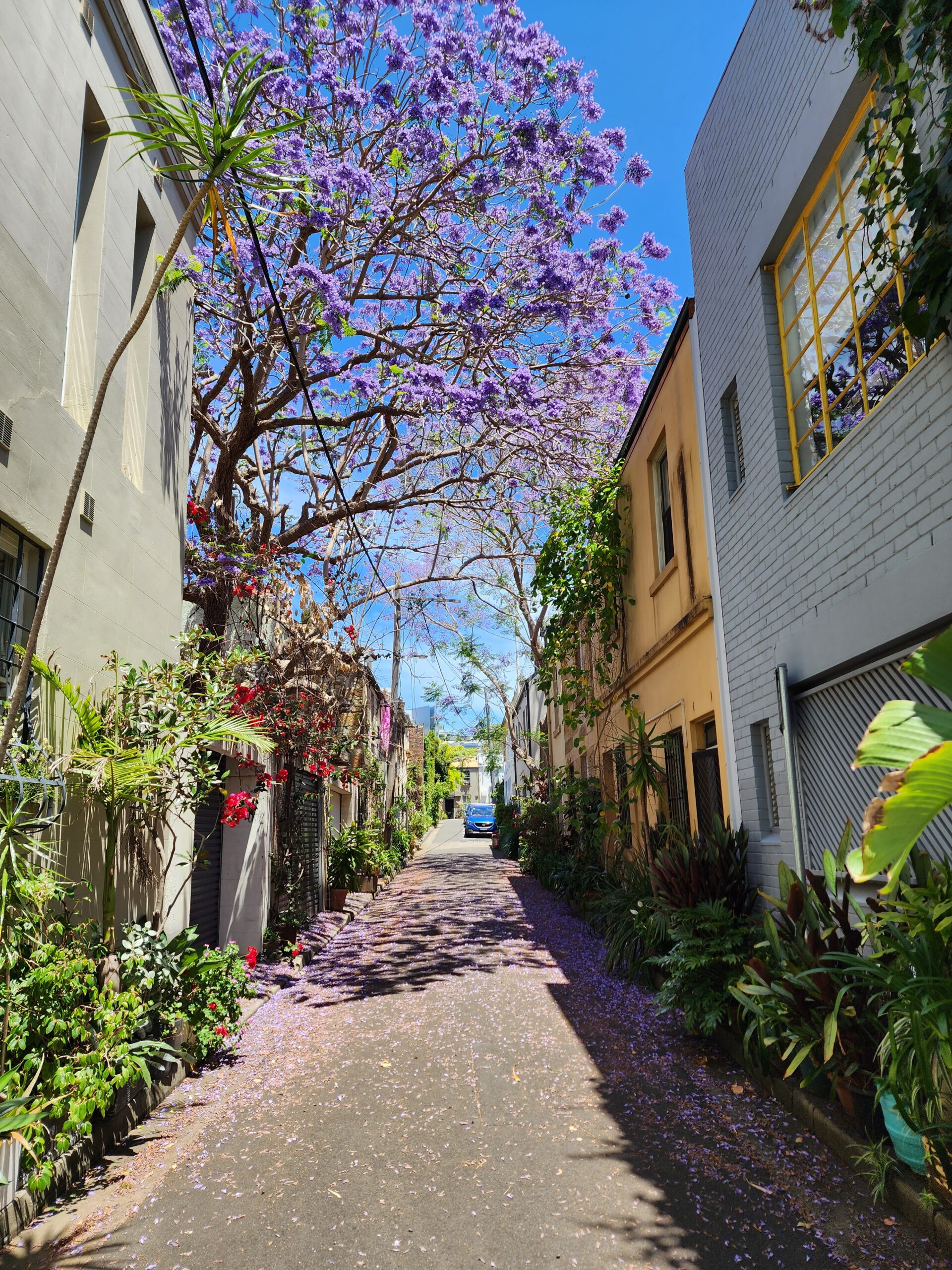
Palmer Lane, Darlinghurst
Once upon a time, lanes like this were run-down slums full of brothels and devoid of colour. This jacaranda must have been a sight to behold and was likely planted in the 1930s.
But the Jacaranda tree I like best belongs to no home of ease and luxury. It grows in a sordid narrow street in Darlinghurst, in a backyard in the midst of a row of unpainted, depressed-looking houses all alike in dinginess and poverty. It is the only brave, beautiful note of color in the unlovely spot, and I think there are many who gain a message of hope and brightness as they look at the ethereal
“jacaranda, “Evening News, 4 December 1922, p.6
lowers which blossom so courageously in the ulgy street. Many hearts will sorrow when the tree’s all-too-brief life is ende —till next November!

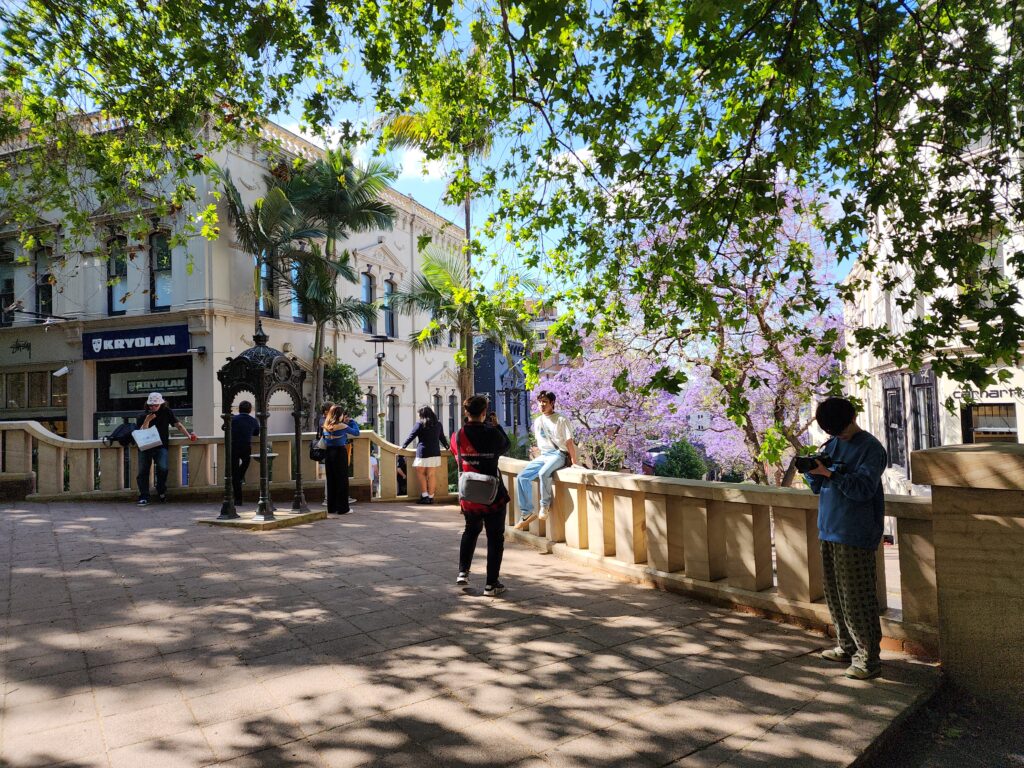
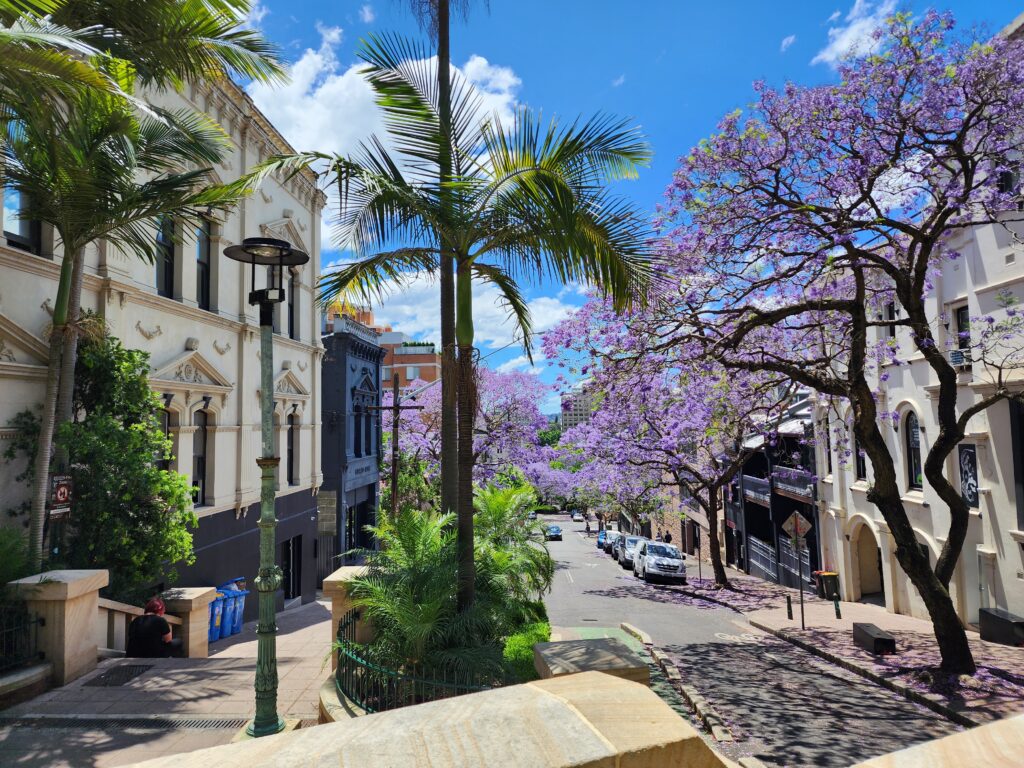
The history of jacarandas in Sydney
Jacarandas were introduced to the country, including Sydney, as ornamental trees. The exact date of their introduction can be a bit challenging to pinpoint, but it is generally believed that Jacaranda trees were initially collected by the botanist Allan Cunningham on his specimen-collecting expedition in Rio de Janeiro for the Kew Gardens in Southwest London in 1816. Cunningham was recommended for the appointed to the position of botanical collector by Joesph Banks. Cunningham spent two years in Brazil and was then ordered to New South Wales. Although Cunningham had a significant career in New South Wales as a botanist and is even buried in the Sydney Botanic Gardens, there is no hard evidence that he brought any specimens with him to Sydney.
One popular narrative is that the first Jacaranda tree in Sydney was planted in 1857 by the director of the Sydney Botanic Gardens at the time, Charles Moore. The earliest reference to a flowering Jacaranda in the Sydney Botanic Gardens is in the Sydney Morning Herald in 1864. By 1868, the flowering was spectacular enough to warrant several articles in the Sydney Morning Herald in early December notifying the readers that it was in full bloom. One article evening stated that people had travelled up to 50 miles to see it. Considering a jacaranda tree planted from seed or sapling usually begins to produce its first blooms when it’s around 7 to 10 years old, it appears this was the first jacaranda planted in the colony. However, there were others.
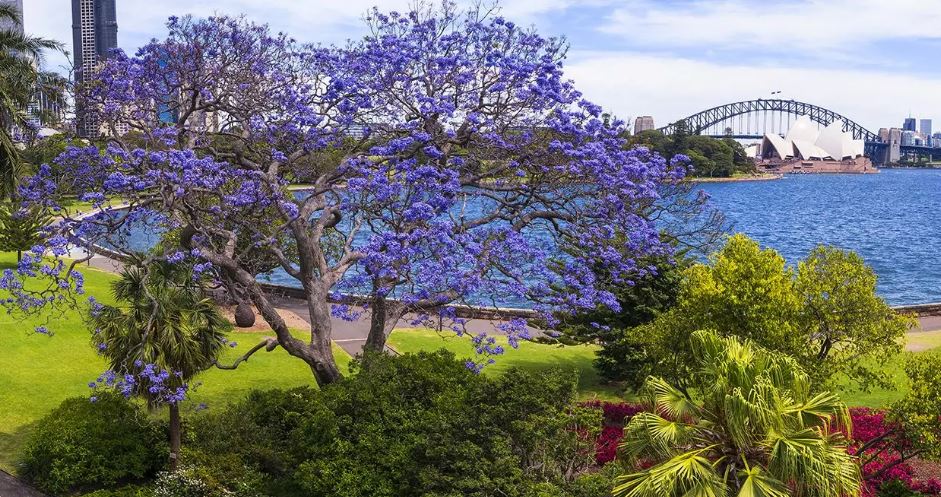
The spread of jacarandas across sydney
With the abundance of jacaranda trees in Sydney today, it seems incredible that in the 1860s, horticulturalists were working tirelessly to successfully propagate the tree from cuttings. We know today that propagation is successful when from fresh seed. However, in the 1860s, the main tree had not produced seeds yet. In 1868, Michael Guilfoyle, a landscape gardener and horticulturalists managed to propagate jacarandas in his Double Bay Exotic Nursery using grafting and artificial heating.
Guilfoyle was commissioned by Thomas Sutcliff Mort in 1851 to design and oversee the development of the grounds and gardens for the Greenoakes Estate, Double Bay. The Nursery was founded soon after. It has been estimated that Guilfoyle planted a jacaranda in the Greenoakes garden circa 1856/57. Likely this was from the same stock as that planted in the Botanic Gardens. The Greenoakes tree was considered one of the finest in the colony in 1876 along with the Botanic Garden’s tree.
Once the plant was propagated, nurseries across the colony were in possession of jacaranda seedlings by 1878. By the end of the decade, jacarandas were scattered across the Eastern Suburbs of Sydney, particularly around Woollahra and Double Bay. Jacarandas had reached Sydney’s North Shore by the 1890s with one specimen being planted in the Killara Railway Station garden circa 1900. In 1928, a jacaranda was planted in the south-eastern corner of the University of Sydney quadrangle building, this tree was perhaps the most iconic jacaranda in Australia until it fell down in 2016. It has since been replaced with a clone.
Some jacarandas in the City of Sydney were planted in the 1970s during a campaign to transform the bleak, rundown old streets into healthy green spaces.
jacarandas in Australian culture
The jacaranda quickly became symbolic of the idyllic peacefulness of the Australian way of life. The tree is found in the countryside, the suburbs and the city. Very few experiences are as magical as having a picnic under the shade of a jacaranda tree in full bloom during spring.
Too few alas! of gracious deeds
JACARANDA TREE by Emily Bulcock (1923)
Were given to life by me.
But once, with Springtime in my blood,
I planted in a buoyant mood
A jacaranda tree.
Now, with its branches gemmed in flowers,
It sheds its sweets in lilac showers—
A winsome sight to see.
It brings to my life’s darkening room
A marvellous glow to light the gloom,
Clothes it anew with bud and bloom;
It sings my songs for me.
jacarandas in Poetry
Between 1900 and 1960, the jacaranda was the focus of, or featured in, various poems published in newspapers across Australia.

Want to see the darlinghurst jacarandas?
The Walk Talk Explore: East Sydney Historical Walking Tour crosses through Riley Street and Palmer Lane, Darlinghurst during the jacaranda season, passing all the beautiful flowering trees and classic architecture pictured in this article.
After the tour, your guide will direct you to Oxford Square and Theeca Cafe for you to see the spectacular view of Riley Street in bloom over coffee and brunch.
